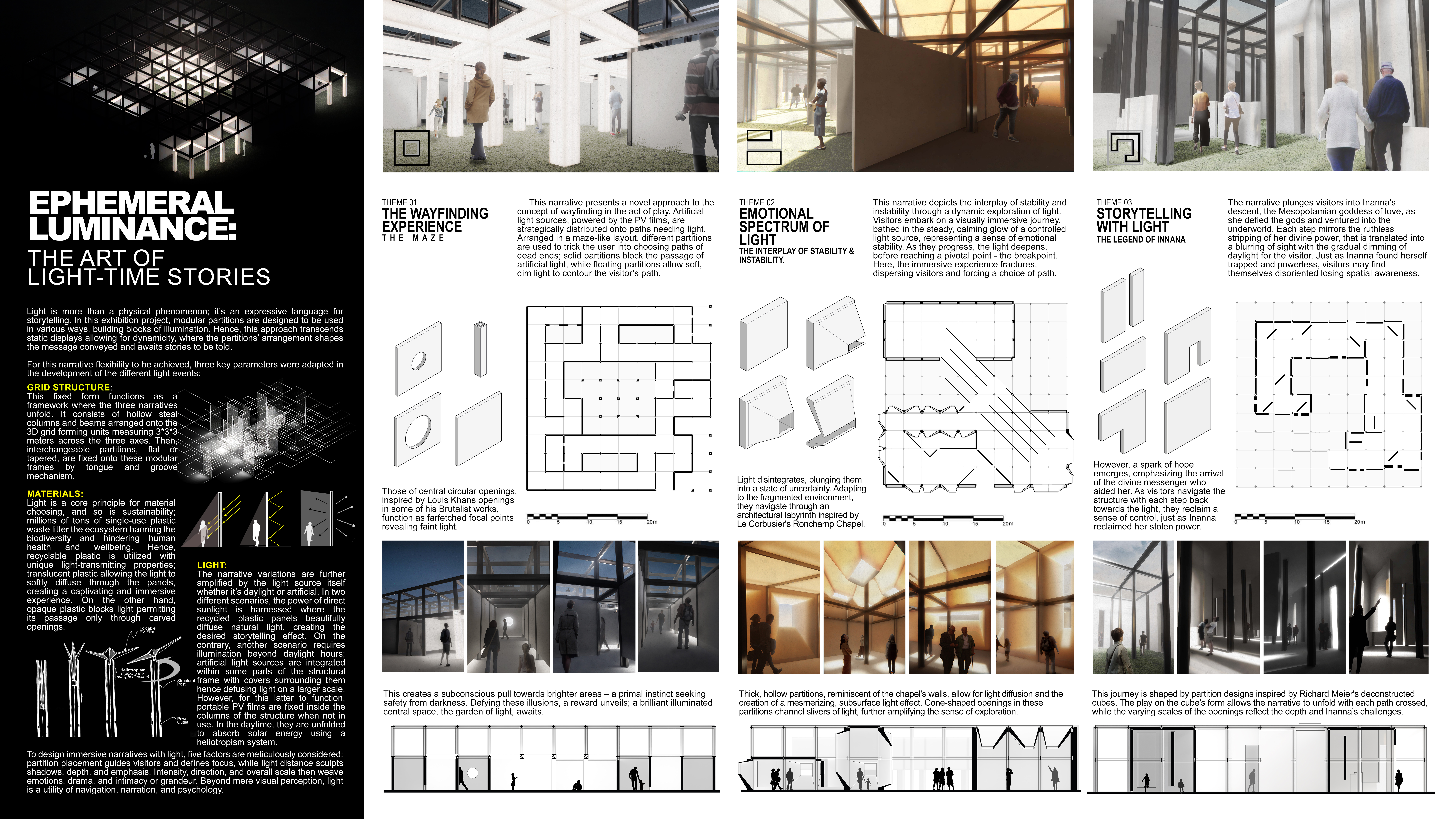2024 - EPHEMERAL LUMINANCE: THE ART OF LIGHT-TIME STORIES

Category
Daylight in Buildings - Region 2: Eastern Europe and The Middle East
Students
Nour ElDin Ibrahim, Nadia Abedal Sater & Myriam Sahmarani
Teacher
Mohamed Sobhy
School
Beirut Arab University
Country
Lebanon
Download
Download project board
- Grid Structure: This fixed form functions as a framework where the three narratives unfold. It consists of hollow steel columns and beams arranged onto the 3D grid forming units measuring 333 meters across the three axes. Then, interchangeable partitions, flat or tapered, are fixed onto these modular frames by tongue and groove mechanism.
- Materials: Light is a core principle for material choosing, and so is sustainability; millions of tons of single-use plastic waste litter the ecosystem harming the biodiversity and hindering human health and wellbeing. Hence, recyclable plastic is utilized with unique light-transmitting properties; translucent plastic allowing the light to softly diffuse through the panels, creating a captivating and immersive experience. On the other hand, opaque plastic blocks light permitting its passage only through carved openings.
- Light: The narrative variations are further amplified by the light source itself whether it’s daylight or artificial. In two different scenarios, the power of direct sunlight is harnessed where the recycled plastic panels beautifully diffuse natural light, creating the desired storytelling effect. On the contrary, another scenario requires illumination beyond daylight hours; artificial light sources are integrated within some parts of the structural frame with covers surrounding them hence diffusing light on a larger scale. However, for this latter to function, portable PV films are fixed inside the columns of the structure when not in use. In the daytime, they are unfolded to absorb solar energy using a heliotropism system.
- Wayfinding with Light: Unveiling Brilliance: This narrative presents a novel approach to the concept of wayfinding in the act of play. Artificial light sources, powered by the PV films, are strategically distributed onto paths needing light. Arranged in a maze-like layout, different partitions are used to trick the user into choosing paths of dead ends; solid partitions block the passage of artificial light, while floating partitions allow soft, dim light to contour the visitor’s path. Those of central circular openings, inspired by Louis Kahn’s openings in some of his Brutalist works, function as farfetched focal points revealing faint light. This creates a subconscious pull towards brighter areas – a primal instinct seeking safety from darkness. Defying these illusions, a reward unveils; a brilliant illuminated central space, the garden of light, awaits.
- Storytelling with Light: The Legend of Inanna: The narrative plunges visitors into Inanna’s descent, the Mesopotamian goddess of love, as she defied the gods and ventured into the underworld. Each step mirrors the ruthless stripping of her divine power, that is translated into a blurring of sight with the gradual dimming of daylight for the visitor. Just as Inanna found herself trapped and powerless, visitors may find themselves disoriented losing spatial awareness. However, a spark of hope emerges, emphasizing the arrival of the divine messenger who aided her. As visitors navigate the structure with each step back towards the light, they reclaim a sense of control, just as Inanna reclaimed her stolen power. This journey is shaped by partition designs inspired by Richard Meier’s deconstructed cubes. The play on the cube’s form allows the narrative to unfold with each path crossed, while the varying scales of the openings reflect the depth and Inanna’s challenges.
- Emotion with Light: Interplay of Stability and Instability: This narrative depicts the interplay of stability and instability through a dynamic exploration of daylight. Visitors embark on a visually immersive journey, bathed in the steady, calming glow of a controlled light source, representing a sense of emotional stability. As they progress, the light deepens, before reaching the breakpoint. Here, the immersive experience fractures, dispersing visitors and forcing a choice of path. Light disintegrates towards a state of uncertainty. Adapting to the fragmented environment, they navigate through an architectural labyrinth inspired by Le Corbusier’s Ronchamp Chapel. Thick, hollow partitions, reminiscent of the chapel’s walls, allow for light diffusion and the creation of a mesmerizing, subsurface light effect. Cone-shaped openings in these partitions channel slivers of light, further amplifying the sense of exploration. Finally, emerging from the fragmented space, visitors arrive at a spiritual oasis bathed in serene ceiling light, a place of reflection after crossing this journey.

























